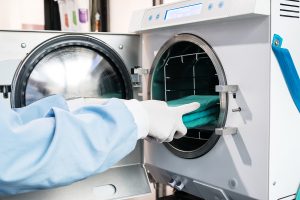The Medical Waste Disposal Process

Because of its hazardous nature, medical waste is disposed of in a process that is different compared to other kinds of waste products.
In general, after the medical waste is collected and separated out by type, it is sterilized before recycling or disposal. In most cases, a modern sterilization tool called an autoclave is used for sterilization. Autoclaves use steam and more environmentally friendly than alternatives like incineration or gas sterilization.
How Medical Waste Disposal Works
 The first step in the medical waste disposal process is collecting the medical waste separated out by type.
The first step in the medical waste disposal process is collecting the medical waste separated out by type.
Hospitals, pharmacies, and other healthcare facilities use different colored bins and bags for the collection of certain types of medical waste.
Red bags, for example, are used for biohazardous waste, while special marked sharps containers are used for needles and other objects that can puncture skin or gloves.
Next, the separated waste is collected and taken to the disposal facility. There, it is placed in the autoclave. Autoclaving sterilizes medical waste by using extremely high-temperature steam to kill viruses, bacteria, and other microorganisms that make the medical waste dangerous.
From there, the now-sterilized medical waste can be recycled or disposed of as normal, since the hazardous pathogens have been killed.
Common Medical Waste Types
Although there are a variety of items that can and do become medical waste, they can generally be placed into 4 main categories:
- Sharps
- Biohazardous or potentially infectious waste (including used bandages and gauze)
- Chemotherapeutic waste
- Pharmaceutical waste (like certain hazardous prescription drugs)
Autoclaving is suitable for most kinds of medical waste, however it is not used for pathological waste, cytotoxic waste, or other hazardous toxic chemical waste. In those cases, incineration or a process called thermal oxidation is used.
Ensuring Compliant Medical Waste Disposal
 Because of how potentially biohazardous it is, medical waste is regulated by several different federal agencies.
Because of how potentially biohazardous it is, medical waste is regulated by several different federal agencies.
The Food and Drug Administration (FDA), the Centers for Disease Control (CDC), and the Occupational Safety and Health Administration (OSHA) are all agencies that have issued regulations regarding medical waste.
To ensure that you’re compliant, it’s important to make sure you are at least familiar with some of the most common regulations, which include
- Precautions and Compliance. Workplaces should have procedures in place for handling biohazardous fluids and materials.
- Training. This can include anything from Bloodborne Pathogens Training to HIPAA Compliance Certification.
- Safety Plans and Safety Audits. Having a plan in place if something goes wrong is crucial to maintaining a safe, compliant work environment. Exposure Control Plans are also required by OSHA to maximize employee safety.
- Workplace Personal Protective Equipment (PPE). Employers are required to provide for employees safety equipment, including gloves and gowns, coats, masks, and eye protection, among other things.
Medical Waste Pros Can Help You With Med Waste Disposal
If you’re in need of medical waste disposal to stay compliant, Medical Waste Pros has you covered. To learn more or get started finding the right service for you, fill out our form or give us a call at (888) 755-6370 for a free, no-obligation quote from medical waste disposal providers near you.










